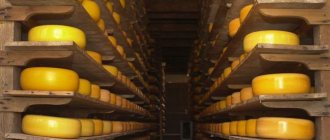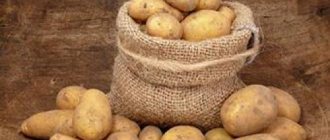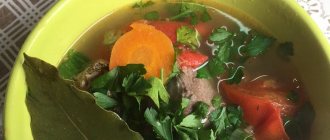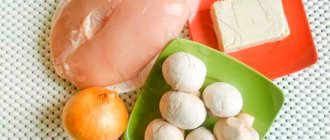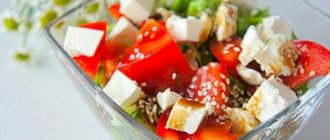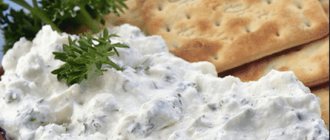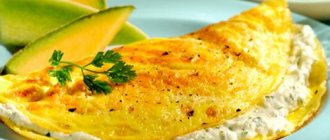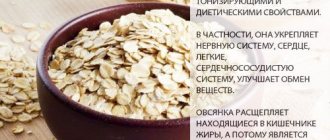Kinds
Numerous varieties of hard cheeses are produced using two methods: boiling or drying with the addition of lactic acid bacteria and enzymes that stimulate the milk coagulation process. This product can mature from three months to three years.
A special niche is occupied by extra-hard cheeses (Italian Parmesan or Swiss Sbrinz), which wait from two to ten years to be ready. The famous Parmesan cheese becomes the hardest product when ripe. It is split with a knife resembling a chisel, as well as with a special hammer that hits the metal insert on the handle of the knife. If the calorie content of Swiss hard cheese of the Sbrinz variety is 429 kcal per 100 g of product, then Italian parmesan is a more dietary option, its energy value is 292 kcal per 100 g.
Extra-hard cheeses are used to prepare gourmet dishes either in grated form or in small crushed pieces. They are also served ready-made in thin shavings as an appetizer with wine. The varieties of hard cheeses include: naturally ripened cheeses (Gouda, Edamer, Maasdam), gourmet blue cheeses (Blau Bastianse, Delfts Blau), peasant cheeses (Beemster, Stolweiker) ), smoked (“Gouda”) or with a red rind (“Doruvael”). The calorie content of hard cheese depends on its fat content, which in Parmesan is 32%, in Dutch cheese - 45%, in Swiss cheese - 50%. It is known that the higher this indicator is for a popular fermented milk product, the tastier it is.
Hard cheeses in Russia are produced: “Dutch”, which corresponds to “Edamsky” from the Netherlands, “Swiss”, English “Cheddar”, “Kostromskoy”, “Rossiysky”, “Sovetsky”, “Yaroslavsky”, “Altaisky” and “Gornoaltaisky” ", "Moscow", "Caucasian", Brie President cheese, smoked varieties and others.
Compound
Cheese contains 26–28% protein, which is absorbed by the human body much better than meat. Nutritionists call solid varieties “concentrated milk” because sometimes a small piece of cheese for breakfast (30–50 g) can replace 300–400 ml of valuable liquid. The high calorie content of hard cheese is associated with the high lipid content in milk (20-28%). They are also rich in vitamins: A, group B (B1, B2, B6, B9, B12), PP, E and C. The product described contains many minerals: zinc, calcium, copper, manganese, sodium, iron, magnesium, potassium , phosphorus. Milk fat has a low-melting structure and a large amount of phosphotites, which contribute to its almost complete absorption (98-99%).
Calories in Gouda Cheese. Chemical composition and nutritional value.
Gouda cheese
is rich in vitamins and minerals such as: vitamin A - 28.7%, vitamin B2 - 16.7%, vitamin B5 - 23.2%, vitamin B12 - 20.7%, vitamin PP - 33.5%, calcium - 100%, magnesium - 11.3%, phosphorus - 80%, chlorine - 57.7%, selenium - 26.4%, zinc - 29.2%
- Vitamin A
is responsible for normal development, reproductive function, skin and eye health, and maintaining immunity. - Vitamin B2
is involved in redox reactions, helps to increase the color sensitivity of the visual analyzer and dark adaptation. Insufficient intake of vitamin B2 is accompanied by impaired condition of the skin, mucous membranes, and impaired light and twilight vision. - Vitamin B5
is involved in protein, fat, carbohydrate metabolism, cholesterol metabolism, the synthesis of a number of hormones, hemoglobin, promotes the absorption of amino acids and sugars in the intestines, and supports the function of the adrenal cortex. A lack of pantothenic acid can lead to damage to the skin and mucous membranes. - Vitamin B12
plays an important role in the metabolism and transformation of amino acids. Folate and vitamin B12 are interconnected vitamins that are involved in hematopoiesis. A lack of vitamin B12 leads to the development of partial or secondary folate deficiency, as well as anemia, leukopenia, and thrombocytopenia. - Vitamin PP
is involved in redox reactions of energy metabolism. Insufficient vitamin intake is accompanied by disruption of the normal condition of the skin, gastrointestinal tract and nervous system. - Calcium
is the main component of our bones, acts as a regulator of the nervous system, and is involved in muscle contraction. Calcium deficiency leads to demineralization of the spine, pelvic bones and lower extremities, increasing the risk of developing osteoporosis. - Magnesium
is involved in energy metabolism, the synthesis of proteins, nucleic acids, has a stabilizing effect on membranes, and is necessary to maintain the homeostasis of calcium, potassium and sodium. A lack of magnesium leads to hypomagnesemia, an increased risk of developing hypertension and heart disease. - Phosphorus
takes part in many physiological processes, including energy metabolism, regulates acid-base balance, is part of phospholipids, nucleotides and nucleic acids, and is necessary for the mineralization of bones and teeth. Deficiency leads to anorexia, anemia, and rickets. - Chlorine
is necessary for the formation and secretion of hydrochloric acid in the body. - Selenium
is an essential element of the antioxidant defense system of the human body, has an immunomodulatory effect, and is involved in the regulation of the action of thyroid hormones. Deficiency leads to Kashin-Beck disease (osteoarthritis with multiple deformities of the joints, spine and limbs), Keshan disease (endemic myocardiopathy), and hereditary thrombasthenia. - Zinc
is part of more than 300 enzymes and is involved in the processes of synthesis and breakdown of carbohydrates, proteins, fats, nucleic acids and in the regulation of the expression of a number of genes. Insufficient consumption leads to anemia, secondary immunodeficiency, liver cirrhosis, sexual dysfunction, and the presence of fetal malformations. Research in recent years has revealed the ability of high doses of zinc to disrupt the absorption of copper and thereby contribute to the development of anemia.
morehide
You can view a complete directory of the healthiest foods in the “My Healthy Diet” app.
Benefit
When consuming hard cheese, which is high in calories, you need to monitor portions in moderation and a sufficient amount of physical activity. This will help burn off the excess energy gained from the nutritious product.
But hard cheeses, if eaten regularly in sufficient quantities, provide a person with the essential amino acids they contain: tryptophan, methionine and lysine. The first helps reduce appetite and is involved in the synthesis of vitamin B3, which is necessary for brain activity. In turn, lysine and methionine help break down fats and slow down the aging process of cells.
Calories in Gouda Cheese. Chemical composition and nutritional value.
Gouda cheese
is rich in vitamins and minerals such as: vitamin A - 18.3%, vitamin B2 - 18.6%, vitamin B12 - 51.3%, calcium - 70%, phosphorus - 68.3%, selenium - 26, 4%, zinc - 32.5%
- Vitamin A
is responsible for normal development, reproductive function, skin and eye health, and maintaining immunity. - Vitamin B2
is involved in redox reactions, helps to increase the color sensitivity of the visual analyzer and dark adaptation. Insufficient intake of vitamin B2 is accompanied by impaired condition of the skin, mucous membranes, and impaired light and twilight vision. - Vitamin B12
plays an important role in the metabolism and transformation of amino acids. Folate and vitamin B12 are interconnected vitamins that are involved in hematopoiesis. A lack of vitamin B12 leads to the development of partial or secondary folate deficiency, as well as anemia, leukopenia, and thrombocytopenia. - Calcium
is the main component of our bones, acts as a regulator of the nervous system, and is involved in muscle contraction. Calcium deficiency leads to demineralization of the spine, pelvic bones and lower extremities, increasing the risk of developing osteoporosis. - Phosphorus
takes part in many physiological processes, including energy metabolism, regulates acid-base balance, is part of phospholipids, nucleotides and nucleic acids, and is necessary for the mineralization of bones and teeth. Deficiency leads to anorexia, anemia, and rickets. - Selenium
is an essential element of the antioxidant defense system of the human body, has an immunomodulatory effect, and is involved in the regulation of the action of thyroid hormones. Deficiency leads to Kashin-Beck disease (osteoarthritis with multiple deformities of the joints, spine and limbs), Keshan disease (endemic myocardiopathy), and hereditary thrombasthenia. - Zinc
is part of more than 300 enzymes and is involved in the processes of synthesis and breakdown of carbohydrates, proteins, fats, nucleic acids and in the regulation of the expression of a number of genes. Insufficient consumption leads to anemia, secondary immunodeficiency, liver cirrhosis, sexual dysfunction, and the presence of fetal malformations. Research in recent years has revealed the ability of high doses of zinc to disrupt the absorption of copper and thereby contribute to the development of anemia.
morehide
You can view a complete directory of the healthiest foods in the “My Healthy Diet” app.
Calorie table for different types of hard cheese
Despite the benefits that hard cheese provides to the body, the calorie content in 100 grams of any type of this product is 17-20% of the total daily diet. Anyone who is watching their figure or their blood cholesterol levels should consume no more than 20–50 g of mature cheese per day.
| Cheese varieties | Fat content | Energy value in kcal per 100 g |
| "Dutch" "Gouda" "Edamian" | 45 % | 340-356 |
| "Gouda" | 48% | 361-362 |
| "Kostroma" | 45% | 345 |
| "Russian" | 45-50% | 337-366 |
| Kondrovo Russian "Olterber" | 50% | 355 |
| "Dobryan" Russian | 50% | 360 |
| "Soviet" | 50% | 356 |
| "Poshekhonsky" | 45% | 350 |
| "Uglichsky" | 45% | 335-347 |
| "Yaroslavsky" | 45% | 361 |
| "Swiss" | 50% | 335-380 |
| "Altaic" | 50% | 355 |
| "Ozerny" | 50% | 350 |
| "Steppe" | 45% | 362 |
| "Cheddar" | 50% | 392-405 |
| "Kaunas" | 30% | 355 |
| "Latvian" | 45% | 316 |
| "Lithuanian" | 30% | 250-338 |
| Lithuanian "Gouda", "Edam" | 45% | 334 |
| "Altaic" | 50% | 356 |
| "Chester" | 50% | 363 |
| Cheese with mushrooms | 50 % | 395 |
| "Emmental" | 45 % | 420 |
| "Parmesan" | 32% | 292 |
| "Gruyere" | 49% | 396 |
| "Munster" | 45% | 365 |
| "Lambert" | 50% | 377 |
| "Appenzeller" | 50 % | 400 |
| "Edamer" | 40 % | 340 |
| "Etorki" (sheep) | 50% | 401 |
| "Roquefort" | 45% | 332-369 |
| "Limburger" | 28% | 327 |
| "Oltermani" | 55% | 400 |
| "Maasdam" | 45% | 340-360 |
When preparing dishes or snacks, hard cheese is often grated to create an appetizing crust. A teaspoon of this delicacy contains 8 g, from which you can get 30 kcal. A tablespoon of grated hard cheese contains 25 g, the calorie content of the product is 94 kcal.
A glass (200 ml) contains 320 g of hard grated cheese with a calorie content of 1200 kcal, and a cup (250 ml) contains 400 g and 1500 kcal, respectively.
Application
The cheese has a pleasant, delicate, creamy taste. The consistency of the product is dense and hard, the cheese has a rich yellow color and a pleasant aroma. The longer the cheese is aged, the richer its taste and smell. Cheese aged for more than one year is considered the highest quality - this cheese is called “Dutch Master”. The holes in the cheese should be round and evenly distributed. Traditionally, Gouda cheese is produced in 12-15 kg heads, but now they also produce 5-6 kg heads, and very small portions. Currently, there is a wide variety of Gouda cheeses with different fat contents, aging and the addition of various ingredients. Often, when making cheese, various dried herbs are added. In addition, Gouda cheese comes in smoked and lightly salted form. Gouda cheese is served as a snack, as an addition to coffee or tea, and is also used as an ingredient in various salads, and added to dishes, such as pizza.
Market Analytics
- COVID-19 is changing the rules of the game in the cosmetics market
- Beauty of the future: cosmetic innovations 2020
- New ingredients are the driving force of the cosmetics industry
Convenient search for beauty salons on our website
Beauty salons in Moscow Beauty salons in St. Petersburg Beauty salons in Ekaterinburg Beauty salons in Novosibirsk
Latest blog posts on our website
- Naturecream / Geranium (Pelargonium) oil for skin health and beauty
- Prostye-sovety / Save on a beauty salon: procedures that can be done at home
- Naturecream / Growth Factor - brings back youth?
- Oksana-Lezina / 3 effective abdominal exercises from a fitness instructor for beginners
- Prostye-sovety / Making perfect curls at home
- Prostye-sovety / Which hair removal method to choose
- Naturecream / Wrinkles Puppets
- Naturecream / PEPHA-TIGHT - instant skin lifting
- Naturecream / Blue light - a danger to the skin
- Naturecream / Cocoa Butter – A treat for the skin
Latest forum topics on our website
- Mrs._Smith / Badly sunburned! What to do?((
- Ice / Is it necessary to combine fitness classes with a diet?
- Antonova / What can be used for hair loss?
- Radio operatorKat / Who was on a protein diet?
- Suzanna / Mesotherapy on the face
Other articles in this section
| Ryazhenka 3.2% The fermented milk product ryazhenka is a traditional drink of Ukrainian cuisine. It is obtained from baked milk and cream by lactic acid fermentation, adding bacteria - Bulgarian bacillus and streptococci. Ryazhenka has a uniform consistency, its color can range from yellowish to pale pink. The product has a creamy milky taste and smell. Most often, fermented baked milk is produced with 3.2% fat content. |
| Dutch cheese Dutch cheese is one of the most popular and widespread varieties of cheese. Its peculiarity is that it is always prepared only from fresh cow's milk, and sterility is a prerequisite for production. The recipe for making Dutch cheese has remained unchanged for about 150 years. It tastes milky, salty and slightly spicy. The color should range from milky white to pale yellow; if the cheese is bright yellow, then coloring has probably been added to it. The ripening period is from 30 to 60 days, no more. |
| Arla Buko cheese The very small state of Denmark in Northern Europe has surpassed many of its neighbors in the production and manufacture of cheese. In this European country, there are two types of traditional cheeses - blue cheese and semi-hard cheese. The high quality and excellent taste of this product is influenced by the rich, centuries-old history of its production. Denmark has now taken a strong position in the world in the production of dairy products. One of the popular and at the same time very healthy and tasty cheeses is the Arla Buko variety. Local companies producing this type of sora successfully follow the entire cheese making process, using only the milk of Danish cows and the addition of natural fillers. Arla Buko cheese resembles the taste of Philadelphia cheese, which is especially popular in Japan. But the advantage of the first is that the price of the product is cheaper, despite small taste differences that are not at all noticeable to ordinary consumers. Arla Buko cheese is very aromatic, fresh, with a sour and delicate taste. |
| Parmesan Cheese In Italy, Parmesan is spoken of as the king of cheeses. To make this type of cheese good, the cows are fed only special grass that grows on pastures in only five provinces of Italy. Milking cows and processing milk should be done only by hand, no equipment is used. In Italy they say that for 800 years no one has violated the rules for making this cheese. In fact, the correct name for the cheese is “Parmigiano-Reggiano”, but in different countries there are a huge number of variations of this cheese, which are called Parmesan. By the way, N.V. was a big fan of Parmesan. Gogol. |
| Whole milk powder Milk powder is produced by evaporation. Manufacturers use regular whole cow's milk and evaporate it until it becomes a powder. Thus, powdered milk is a ready-made dairy product that just needs to be diluted with water. This product is used for cooking, it is taken by athletes - bodybuilders, and powdered milk is used in production. Athletes, in turn, use milk powder instead of protein. |
| Grana Padano cheese Grana Padano cheese is the name of not just one type of cheese, but a whole group. They differ from other varieties both in appearance and geographical location. This is a hard cheese that is very popular in Italy and all over the world. The history of this cheese dates back to Ancient Rome, where it is considered one of the first cheese varieties. It is named after a river called the Po, which flows in Italy. A distinctive feature of this cheese is its grainy structure. Its taste is quite piquant, slightly salty, with a subtle nutty flavor. This cheese is based on cow's milk, which takes a full year and a half to mature. It is quite popular among true gourmets around the globe. And all thanks to its exquisite taste and aroma, which simply does not have anything like it. |
| Cheese Brynza Serbskaya This is an environmentally friendly and natural cheese. Its texture is dense and its color is pure white. The surface of the cheese is smooth, glossy with small cracks. It has a non-intrusive, faint smell with light notes of cream. The taste of Serbian Brynza is fresh, richly salty. Brynza has a long history. It was first made by an Arab merchant when the milk in his wineskin turned sour. Heat and bacteria led to the formation of feta cheese. |
| Cream 20% (medium fat content) Cream comes from milk. This is the top layer that is formed when milk settles in conditions comfortable for this process. At the same time, all the most useful and easily digestible substances are transferred into the cream. The production required a more extensive production output, as a result of which the cream production technology was invented - separation. This is the most effective method, saving time and energy and producing a high-quality product. |
| Milk 1.5% The history of milk goes back to the distant past of mankind. Many scientists constantly argue about when man discovered this valuable drink. But there are many different sources that claim that the discovery of milk and its consumption began more than six thousand years ago. Livestock such as cows and sheep began to be domesticated in the regions of Afghanistan and Iran about nine thousand years ago, even before our era. These animals were grazed on specially designed pastures in Africa and Turkey. |
| Stilton cheese Stilton cheese - the king of English cheeses, the pride of England, appeared at the end of the 18th century and is the youngest of the family of blue cheeses. Only fresh pasteurized milk is used in the production of Stilton, so it is an environmentally friendly product with a shelf life of 2 months. |
Energy value of “Russian” cheese
One of the most popular domestic cheeses, Rossiysky, is produced today in Russia and some neighboring countries. The characteristic features of this type of hard cheese are its pronounced, delicate taste and “fine lace” pattern. “Russian” cheese is prepared from pasteurized milk obtained from cows with the addition of rennet and lactic acid bacteria. The product is aged for 2.5 months and then goes to stores.
The calorie content of Rossiyskiy hard cheese can vary from 337 to 366 kcal. Milk protein is approximately 23%, lipids - about 30% (in dry weight, the fat content of the product does not exceed 50%). This type of cheese is rich in vitamins B, A, E, D and PP. Per 100 g of product there are 0.88 g of calcium, 0.81 g of sodium, 88 mg of potassium and 0.5 g of phosphorus. “Russian” cheese with 45% fat content contains 337 kcal per 100 g of product, the calorie content of hard cheese with 50% fat content (of the same variety) is 358 kcal, and the energy value of Russian “Como” is 363 kcal.
Harm and contraindications
When buying your favorite product, you need to pay attention to its natural composition: adding vegetable fats (palm oil) reduces its cost and significantly deteriorates its quality. It should also be taken into account that people suffering from gastrointestinal problems are prohibited from eating spicy varieties of the described product. Sometimes hard cheese, whose calorie content may be small, causes headaches, migraine attacks or nightmares. This harm is caused by an excess of the amino acid tryptophan coming from cheese. If you overuse solid varieties of the product, this can become a trigger for the occurrence of excess cholesterol in the blood, blood thickening, hypertension or atherosclerosis.
Blue cheese (hard), the calorie content of which is 340-353 kcal per 100 g of a savory product, is prohibited in the diet of pregnant women, since some products with mold contain a dangerous amount of bacteria that cause listeriosis. This disease can lead to problems with pregnancy and birth.
For fitness nutrition
The beneficial properties of hard cheeses are a godsend for a vegetarian menu or for those who want to diversify their protein diet. They act as a replacement for meat or fish. Protein is involved in the formation of muscles and organs, and phosphorus and calcium strengthen the structure of joints and bones. When choosing hard cheeses for your diet while losing weight, you need to pay attention to the product label, which indicates the exact energy value of the product in calories. For example, the calorie content of hard cheese with 45% fat content can vary from 310 kcal to 420 kcal.
At the same time, Cheddar cheese can be produced with either a fat content of 49-50% (405 kcal) or 33%. The calorie content in the second case will be only 380 kcal. A dietary version of this cheese called “Cheddar” contains only 18% fat and has only 282 kcal. At the same time, milk fat is absorbed by the human body quite easily, but a high percentage of lipids can hinder weight loss. Therefore, when losing weight, it is more advisable to eat no more than two cheese slices (plates) in the first half of the day. You can also consume no more than 20 g of your favorite hard cheese before lunch, but no more than twice a week.
The product helps maintain muscle mass and health while fighting extra pounds, but it is necessary to ensure sufficient physical activity.
Calories in Gouda cheese. Chemical composition and nutritional value.
Gouda cheese
is rich in vitamins and minerals such as: vitamin A - 18.3%, vitamin B2 - 18.6%, vitamin B12 - 51.3%, calcium - 70%, phosphorus - 68.3%, selenium - 26, 4%, zinc - 32.5%
- Vitamin A
is responsible for normal development, reproductive function, skin and eye health, and maintaining immunity. - Vitamin B2
is involved in redox reactions, helps to increase the color sensitivity of the visual analyzer and dark adaptation. Insufficient intake of vitamin B2 is accompanied by impaired condition of the skin, mucous membranes, and impaired light and twilight vision. - Vitamin B12
plays an important role in the metabolism and transformation of amino acids. Folate and vitamin B12 are interconnected vitamins that are involved in hematopoiesis. A lack of vitamin B12 leads to the development of partial or secondary folate deficiency, as well as anemia, leukopenia, and thrombocytopenia. - Calcium
is the main component of our bones, acts as a regulator of the nervous system, and is involved in muscle contraction. Calcium deficiency leads to demineralization of the spine, pelvic bones and lower extremities, increasing the risk of developing osteoporosis. - Phosphorus
takes part in many physiological processes, including energy metabolism, regulates acid-base balance, is part of phospholipids, nucleotides and nucleic acids, and is necessary for the mineralization of bones and teeth. Deficiency leads to anorexia, anemia, and rickets. - Selenium
is an essential element of the antioxidant defense system of the human body, has an immunomodulatory effect, and is involved in the regulation of the action of thyroid hormones. Deficiency leads to Kashin-Beck disease (osteoarthritis with multiple deformities of the joints, spine and limbs), Keshan disease (endemic myocardiopathy), and hereditary thrombasthenia. - Zinc
is part of more than 300 enzymes and is involved in the processes of synthesis and breakdown of carbohydrates, proteins, fats, nucleic acids and in the regulation of the expression of a number of genes. Insufficient consumption leads to anemia, secondary immunodeficiency, liver cirrhosis, sexual dysfunction, and the presence of fetal malformations. Research in recent years has revealed the ability of high doses of zinc to disrupt the absorption of copper and thereby contribute to the development of anemia.
morehide
You can view a complete directory of the healthiest foods in the “My Healthy Diet” app.
Dietary dish of zucchini with grated cheese
Products you will need: 1 kg of zucchini, 15 g of sunflower oil, 40 g of corn flour, 1-2 eggs, 200 g of Adyghe cheese and 150 g of “Russian” cheese, 1-2 cloves of garlic (to taste), fresh parsley. In order to prepare a delicious dietary casserole, grate the zucchini on a coarse grater and sprinkle with salt. Then they are allowed to settle and the excess liquid is drained, squeezing out the mass. Add grated cheese, chopped parsley, favorite spices, squeeze out the garlic. Mix with flour and egg, giving the mass homogeneity. Grease a baking tray with oil, pour the future casserole onto it and level the surface. Sprinkle with cheese and bake at 180 degrees for 30-40 minutes. The calorie content of this dish is 156 kcal per 100 g of casserole.
